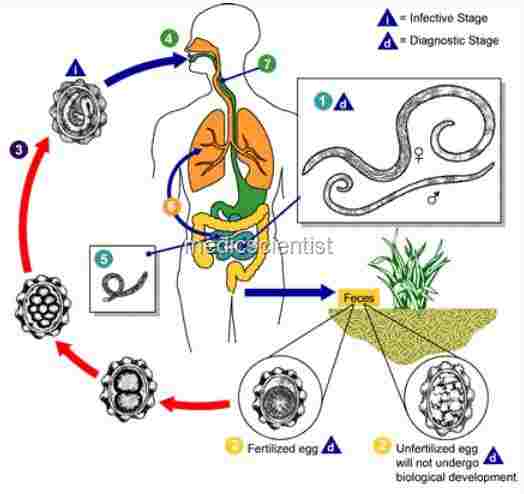Intestinal Nematodes Infaction ASCARIS LUMBRICOIDES
Ascaris lumbricoides is a species of Ascaris that lives in the human intestine and adults may grow to 12 in. long. Eggs are passed with the feces and require at least 2 weeks’ incubation in the soil before they become infective Ascaris lumbricoides, an intestinal roundworm, is one of the most common helminthic human infections worldwide.
 |
| Intestinal Nematodes Infaction ASCARISLUMBRICOIDES |
- It is estimated that more than 1.4 billion people are infected with A. lumbricoides, representing 25 percent of the world population.
- The highest prevalence of ascariasis occurs in tropical countries where warm, wet climates provide environmental conditions that favor year-round transmission of infection.
- This contrasts to the situation in dry areas where transmission is seasonal, occurring predominantly during the rainy months
ASCARIS LUMBRICOIDES is found worldwide.
- Transmission is enhanced by the fact that individuals can be asymptomatically infected and can continue to shed eggs for years, yet prior infection does not confer protective immunity
- Infective stage is egg.
- Route of infection is oral.
- The gastrointestinal location of worms is small intestine.
- In a 1- to 2-year life span, the female is capable of producing 200,000 eggs per day.
- The eggs are passed with the feces, and a new cycle is started.
- Children up to the ages of 12 to 14 are likely to be infected.
- Adult worm size is 20 – 40 cm.
- The worm passes through the lungs also.
- Intestinal obstruction may be a complication in children under 6 years of age.
 |
| Nematodes ASCARIS LUMBRICOIDES |
Incubation period of Nematodes ASCARIS
- Transmission occurs mainly via ingestion of water or food (raw vegetables or fruit in particular) contaminated with A. lumbricoides eggs and occasionally via inhalation of contaminated dust.
- When infections with only female worms occurs, infertile eggs that do not develop into the infectious stage are produced.
- With male-only worm infections, no eggs are formed.
- · 65 – 70 days and may survive for one year.
- Larvae usually reach the lungs by four days after ingestion of eggs.
- Within the alveoli of the lungs, the larvae mature over a period of approximately 10 days,
- · Principal symptoms are gastrointestinal and biliaryobstruction.
 |
| Nematodes ASCARIS LUMBRICOIDES Life Cycle |
CLINICAL FEATURES —
- Direct tissue damage The immunologic response of the host to infection with larvae, eggs or adult worms ,
- Pulmonary and hypersensitivity
- manifestations Intestinal symptoms Intestinal obstruction
- Hepatobiliary and pancreatic symptoms
- Obstruction of an orifice or the lumen of the gastrointestinal tract by an aggregation of worms
Diagnosis of Nematodes ASCARIS
- • By examination of eggs in the stool.
Treatment of Nematodes ASCARIS
- The mainstays of treatment are the benzimidazoles mebendazole and albendazole.
- Mebendazole (100 mg BID for 3 days or 500 mg as a single dose) is an alternative
- A single dose of albendazole (400 mg) is effective in almost 100 percent of cases, although reinfection commonly occurs,
- a single does of either 400 mg albendazole or 200 mcg/kg ivermectin showed similar cure rates (70 percent versus 78 percent) and egg reduction rates (93 percent versus 94 percent) for both therapies,
- However, they should not be given during pregnancy because of possible teratogenic effects; pyrantel pamoate should be used in pregnancy.
- Mebendazole,
- Albendazole,
- Pyrantel pamoate.

